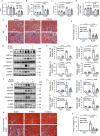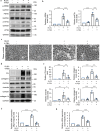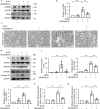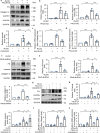Endoplasmic reticulum stress contributes to cisplatin-induced chronic kidney disease via the PERK-PKCδ pathway
- PMID: 35895146
- PMCID: PMC11072288
- DOI: 10.1007/s00018-022-04480-2
Endoplasmic reticulum stress contributes to cisplatin-induced chronic kidney disease via the PERK-PKCδ pathway
Abstract
Background: Cisplatin is an effective chemotherapeutic drug, but it may induce both acute and chronic kidney problems. The pathogenesis of chronic kidney disease (CKD) associated with cisplatin chemotherapy remains largely unclear.
Methods: Mice and renal tubular cells were subjected to repeated low-dose cisplatin (RLDC) treatment to induce CKD and related pathological changes. The roles of endoplasmic reticulum (ER) stress, PERK, and protein kinase C-δ (PKCδ) were determined using pharmacological inhibitors and genetic manipulation.
Results: ER stress was induced by RLDC in kidney tubular cells in both in vivo and in vitro models. ER stress inhibitors given immediately after RLDC attenuated kidney dysfunction, tubular atrophy, kidney fibrosis, and inflammation in mice. In cultured renal proximal tubular cells, inhibitors of ER stress or its signaling kinase PERK also suppressed RLDC-induced fibrotic changes and the expression of inflammatory cytokines. Interestingly, RLDC-induced PKCδ activation, which was blocked by ER stress or PERK inhibitors, suggesting PKCδ may act downstream of PERK. Indeed, suppression of PKCδ with a kinase-dead PKCδ (PKCδ-KD) or Pkcδ-shRNA attenuated RLDC-induced fibrotic and inflammatory changes. Moreover, the expression of active PKCδ-catalytic fragment (PKCδ-CF) diminished the beneficial effects of PERK inhibitor in RLDC-treated cells. Co-immunoprecipitation assay further suggested PERK binding to PKCδ.
Conclusion: These results indicate that ER stress contributes to chronic kidney pathologies following cisplatin chemotherapy via the PERK-PKCδ pathway.
Keywords: Chronic nephrotoxicity; Kidney repair; Protein kinase C-δ; Unfolded protein response.
© 2022. This is a U.S. Government work and not under copyright protection in the US; foreign copyright protection may apply.
Conflict of interest statement
All authors declared no competing interests.
Figures







Similar articles
-
The STAT1/HMGB1/NF-κB pathway in chronic inflammation and kidney injury after cisplatin exposure.Theranostics. 2023 May 8;13(9):2757-2773. doi: 10.7150/thno.81406. eCollection 2023. Theranostics. 2023. PMID: 37284446 Free PMC article.
-
Tubular cell senescence promotes maladaptive kidney repair and chronic kidney disease after cisplatin nephrotoxicity.JCI Insight. 2023 Apr 24;8(8):e166643. doi: 10.1172/jci.insight.166643. JCI Insight. 2023. PMID: 36917180 Free PMC article.
-
Reciprocal regulation between ER stress and autophagy in renal tubular fibrosis and apoptosis.Cell Death Dis. 2021 Oct 29;12(11):1016. doi: 10.1038/s41419-021-04274-7. Cell Death Dis. 2021. PMID: 34716302 Free PMC article.
-
A comparative review of murine models of repeated low-dose cisplatin-induced chronic kidney disease.Lab Anim (NY). 2025 Feb;54(2):42-49. doi: 10.1038/s41684-024-01504-1. Epub 2025 Jan 30. Lab Anim (NY). 2025. PMID: 39885282 Review.
-
Mechanisms of disordered neurodegenerative function: concepts and facts about the different roles of the protein kinase RNA-like endoplasmic reticulum kinase (PERK).Rev Neurosci. 2018 Jun 27;29(4):387-415. doi: 10.1515/revneuro-2017-0071. Rev Neurosci. 2018. PMID: 29303785 Review.
Cited by
-
Small GTP-binding protein GDP dissociation stimulator influences cisplatin-induced acute kidney injury via PERK-dependent ER stress.Commun Biol. 2024 Sep 5;7(1):1091. doi: 10.1038/s42003-024-06792-4. Commun Biol. 2024. PMID: 39237614 Free PMC article.
-
Rodent models of AKI and AKI-CKD transition: an update in 2024.Am J Physiol Renal Physiol. 2024 Apr 1;326(4):F563-F583. doi: 10.1152/ajprenal.00402.2023. Epub 2024 Feb 1. Am J Physiol Renal Physiol. 2024. PMID: 38299215 Free PMC article. Review.
-
Artemisinin alleviates cisplatin-induced damage in GC-1 spermatogonia through ER stress mechanisms.Heliyon. 2025 Feb 8;11(4):e42579. doi: 10.1016/j.heliyon.2025.e42579. eCollection 2025 Feb 28. Heliyon. 2025. PMID: 40034267 Free PMC article.
-
Stearoyl CoA desaturase inhibition can effectively induce apoptosis in bladder cancer stem cells.Cancer Cell Int. 2024 Oct 29;24(1):357. doi: 10.1186/s12935-024-03540-w. Cancer Cell Int. 2024. PMID: 39472909 Free PMC article.
-
Sodium Phenylbutyrate Attenuates Cisplatin-Induced Acute Kidney Injury Through Inhibition of Pyruvate Dehydrogenase Kinase 4.Biomedicines. 2024 Dec 11;12(12):2815. doi: 10.3390/biomedicines12122815. Biomedicines. 2024. PMID: 39767721 Free PMC article.
References
-
- Galgamuwa R, Hardy K, Dahlstrom JE, Blackburn AC, Wium E, Rooke M, Cappello JY, Tummala P, Patel HR, Chuah A, Tian L, McMorrow L, Board PG, Theodoratos A. Dichloroacetate prevents cisplatin-induced nephrotoxicity without compromising cisplatin anticancer properties. J Am Soc Nephrol. 2016;27(11):3331–3344. doi: 10.1681/ASN.2015070827. - DOI - PMC - PubMed
-
- Gu X, Yang H, Sheng X, Ko YA, Qiu C, Park J, Huang S, Kember R, Judy RL, Park J, Damrauer SM, Nadkarni G, Loos RJF, My VTH, Chaudhary K, Bottinger EP, Paranjpe I, Saha A, Brown C, Akilesh S, Hung AM, Palmer M, Baras A, Overton JD, Reid J, Ritchie M, Rader DJ, Susztak K. Kidney disease genetic risk variants alter lysosomal beta-mannosidase (MANBA) expression and disease severity. Sci Transl Med. 2021 doi: 10.1126/scitranslmed.aaz1458. - DOI - PMC - PubMed
MeSH terms
Substances
Grants and funding
LinkOut - more resources
Full Text Sources
Medical

